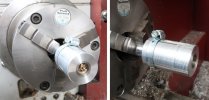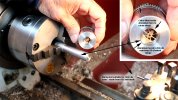Brian McKenzie
Western Thunderer
Something I've wanted to try is to equip a CNC milling machine for embossing rivet heads.
The first version was a spring-loaded tool fitted directly into the machine spindle, but the spring used was far too feeble to make any impression. Being mindful of applying shock loads to the spindle bearings, a more complex arrangement of turnings was assembled to transmit the minor impacts straight into the machine body, avoiding the spindle. This unit is held in position by the air-operated fingers that grip the 'pull-stud' that is screwed into the upper end of regular tool holders or chucks.


Although a die plate was made for the bogie sideframe example in the video below, the concept works sufficiently well to be worth devising a single fixed female die - and using the CNC motion to feed the sheet metal over it - thus obtaining rivet patterns quickly off any digital plan.
The first version was a spring-loaded tool fitted directly into the machine spindle, but the spring used was far too feeble to make any impression. Being mindful of applying shock loads to the spindle bearings, a more complex arrangement of turnings was assembled to transmit the minor impacts straight into the machine body, avoiding the spindle. This unit is held in position by the air-operated fingers that grip the 'pull-stud' that is screwed into the upper end of regular tool holders or chucks.

Although a die plate was made for the bogie sideframe example in the video below, the concept works sufficiently well to be worth devising a single fixed female die - and using the CNC motion to feed the sheet metal over it - thus obtaining rivet patterns quickly off any digital plan.
Last edited:






